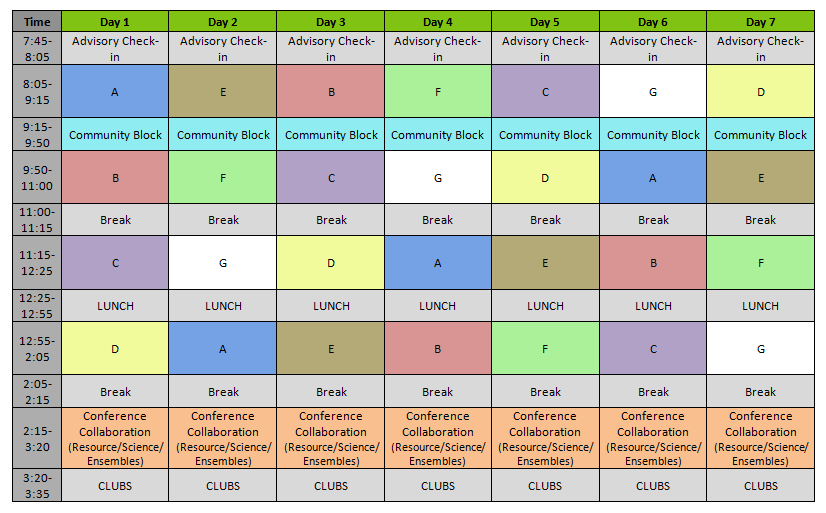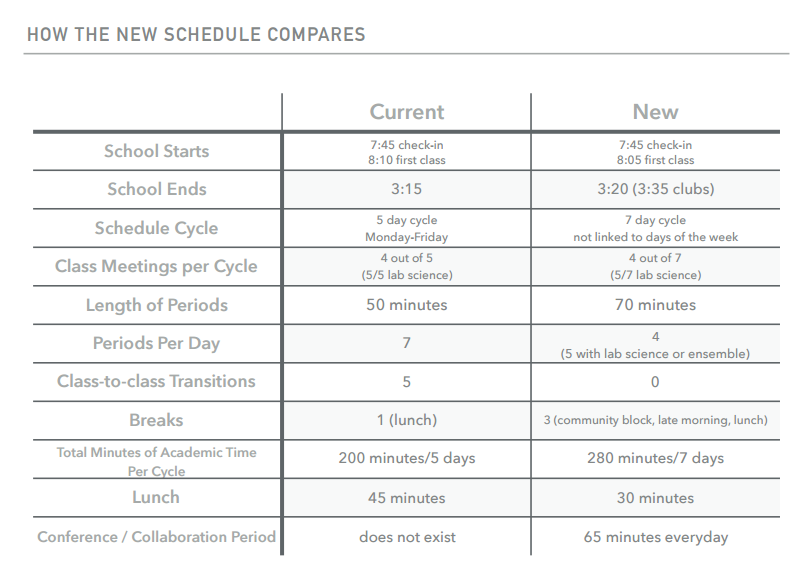New schedule for 2017-2018 school year


After 18 months of planning and revising, the new schedule for next year has been finalized. This new schedule was created with the goal of improving the school day from a student perspective, and to better reflect the more creative, dynamic curriculum that is being offered next year. Instead of seven 50-minute blocks, students will now have four or five 70-minute periods. The schedule is based on a 7-day cycle, rather than being linked to days of the week. This rotation is designed to prevent certain classes from disproportionately missing days due to holidays and other missed days. Additionally, with built-in breaks, there are no longer back-to-back classes. Lunch is shortened to 30 minutes, but there is a 65-minute conference/collaboration period, as well as a 45-minute community block, both of which are times for students to meet with teachers, get homework done, or simply have some much-needed relaxation time. Aside from the daily schedule, PDS will be changing from a trimester system to a semester system, which will hopefully give students more opportunities within each marking period to demonstrate their understanding, so there will be less “high-stakes” assessments. While these differences will be very new for PDS’ students, similar schedules are being used in peer schools and colleges.
“If schools are to evolve, you have to always be thinking about curriculum and schedule,” said Head of the Upper School Jason Robinson, who has led the schedule committee consisting of faculty members from all three divisions. One of the main purposes of the new schedule is to provide students with a more relaxed school day where they can thrive both in their classes and in their personal lives. “On the health and wellness side, a big goal was to make the day itself better paced,” described Mr. Robinson.
With 70-minute periods and breaks in between every academic class, students will hopefully be able to devote more attention to each subject, while also having more time to adjust before moving on to the next subject. Mr. Robinson was also clear that students should not expect longer periods to look like the extended versions of the classes they are in now. “70 minutes of lecture is not the intention…With 70 minutes, the hope is that teachers can make use of the rich variety of different pedagogies that are available to them today,” said Mr. Robinson. A typical class could include “a little bit of framing at the beginning, followed by a small group exercise, followed by a presentation, followed by an exercise where you reflect and write on what you’ve just learned.” With more time for each lesson, teachers can help students learn to apply lessons to the real world, a very necessary skill for students today. As Mr. Robinson stated, “The mark of an educated person in the 21st century is not what they know, in a passive sense, but what they can do with what they know.”
While it may take students and teachers some time to adjust to these changes, it is the administration’s hope that students will benefit from a better-paced school day and more meaningful lessons in each class.

